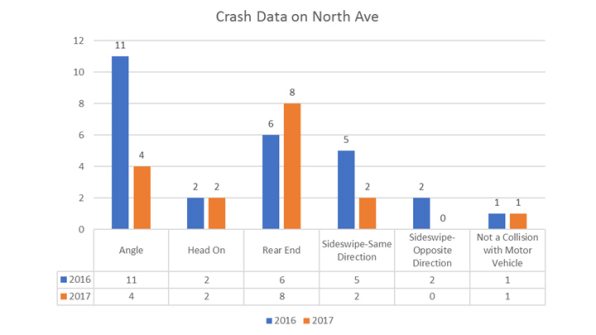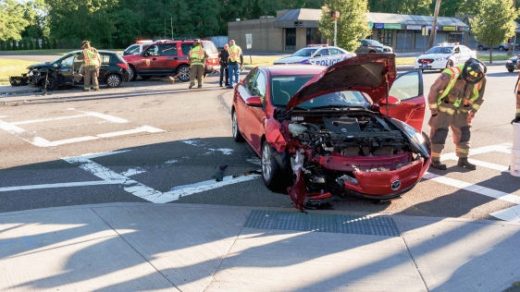Can The Private Sector Help Cities Stop Traffic Deaths?
The city of Atlanta has a problem on North Avenue, a major road that runs east-west through the Georgia Tech campus north of downtown. The crash rate on the major artery is more than 200% worse than the statewide average for similar corridors–which is especially concerning given that North Avenue is served by numerous key transit lines, and intersects with several bicycle routes.
“We had been actively seeking new technologies and opportunities that could help us enhance and improve the safety of North Avenue,” says Faye DiMassimo, the general manager for Renew Atlanta, a $252 million infrastructure bond program introduced in 2015 to begin to address the city’s $900 million backlog in infrastructure improvement needs. That search, DiMassimo says, lead Renew Atlanta to apply to a new road safety accelerator program that helped the agency, along with Georgia Tech, build out a North Avenue Smart Corridor–a project that, since launching in September, has seen the addition of over 100 data-collecting sensors, a new traffic signal system that responds to current conditions on the corridor, and a pilot of an autonomous bus network that will connect to the sensor system.
The accelerator program that collaborated with Renew Atlanta on the Smart Corridor is called the Safer Roads Challenge, and hosted by Together for Safer Roads (TSR)–a coalition of private companies committed to pooling their resources to work toward ending traffic crashes, the eighth leading cause of death worldwide. TSR launched in late 2015 with leadership from companies like AIG, Anheuser-Busch InBev, IBM, and AT&T, which are contributing data analysis, analytics systems, and business expertise toward traffic safety initiatives worldwide.

Admittedly, this seems like a strange coalition of companies to get involved in road safety, but when you consider the stakes these companies have in the issue, a clearer picture starts to form. For insurance companies like AIG, reducing traffic crashes means reducing the number of claims they have to pay out; AB InBev and AT&T both oversee large fleets of vehicles that traverse the country making shipments or responding to customer needs. And there’s a pretty obvious image-correcting effort at work here: AB InBev is an alcohol company, and AT&T is a cell phone company; together, in the popular imagination, they represent two of the most common causes of driving-related deaths. It’s no wonder the companies would jump at an opportunity to associate themselves with road safety.
Self-serving as TSR may be, though, reducing traffic crashes is the kind of effort that will require creative input from every aspect of society and industry. In 2010, the U.N. announced “A Decade of Action for Road Safety,” a mandate to save 5 million lives over the course of 10 years (around a 50% reduction from current rates) by creating safer vehicles and improving road safety and management, among other initiatives. But halfway through the decade, says TSR President David Braunstein, “things were not going the way the UN had hoped.” Annual traffic deaths still number around 1.25 million; injuries around 50 million. That stagnation in progress, Braunstein adds, served as the inspiration for TSR.
A number of cities across the world have joined Vision Zero, an initiative to end traffic deaths through a combination of urban design, policy, and enforcement. Like the results of the U.N.’s push, however, most cities with Vision Zero initiatives have followed through with only slow or half-hearted implementation of the policies. TSR, Braunstein says, is aiming to act as the private-sector response to both of these efforts, and one that will hopefully accelerate progress by injecting some more data and innovative technology into the landscape.
“A lot of the work we’re doing is like what you see in Atlanta: building out new crash analytics systems,” Braunstein says. “You can’t solve that problem if you don’t know when and where crashes happen. And as businesses, we feel very comfortable using analytics as a means to power this work.” In some instances, Braunstein says, that might mean a team of data specialists from TSR working with a city to aggregate and refine publicly available data that the city has neither the time nor the resources to dig into. For crashes, Braunstein says, the ideal system would overlay data from hospitals with police reports and department of transportation data. If cities don’t have the resources to aggregate and analyze that data, he says, a team of specialists from IBM, which helped Atlanta design its Smart Corridor, certainly could.
TSR is also working on growing a network of traffic-safety startups to deploy their technology in hyperlocal test projects, like the North Avenue Smart Corridor. To that end, TSR launched a Global Entrepreneurship Program in November that will bring together three traffic-safety startups looking to scale their technologies up to the city level. The first cohort includes HAAS Alert, a mobile vehicle-to-vehicle alert system that will notify drivers well in advance of when emergency vehicles are trying to make their way through traffic, to avoid the last-minute scramble to get out of the way that often results in further collisions. The other two startups in the cohort are Ouster, a network of sensors for commercial vehicles that will notify drivers when pedestrians, cyclists, or other vehicles are approaching, and ZenDrive, which uses mobile data to detect dangerous driver behavior.
The hope is for cities looking to advance traffic-safety initiatives like Vision Zero to partner with TSR and gain access to the coalition’s data-analytics capabilities, and eventually, the tools their member startups are working on.
In Atlanta, the partnership has already proven fruitful. IBM helped the city analyze data from the city’s public works and emergency services sectors, as well as insurance-claims data from AIG, and traffic congestion data from INRIX, an IBM partner company that studies road conditions down to the street level. They also brought in weather-condition data from the Weather Company, which is owned by IBM, and events data from the city, to determine if there was a correlation in crashes tied to extreme weather or, say, a football match at the Georgia Dome (shocker: there was). Their insights helped the city determine where to install sensors and tweak traffic light timing along the corridor.
As a result of the initial safety efforts on North Avenue in Atlanta, crashes have dropped from 27 in October and November of 2016 to 17 in the same time frame this year. The collaboration between TSR and the City of Atlanta will ultimately evolve into a dashboard that uses predictive analytics to determine when crashes are most likely to happen and to intervene accordingly.
That predictive capability will hopefully, DiMassimo says, help the city get the number of crashes on the corridor down to zero–and use that momentum to expand the Smart Corridor project out to other avenues. The city is also looking into building out more sensors in the mass transit and commercial vehicles that traverse the corridor–something the three TSR partner startups could potentially assist with. TSR is hopeful that Atlanta’s success will encourage more cities to tap into their network of resources. “That’s the thing that we keep hearing from cities, that public-private partnership like this are going to be more important than ever before,” Braunstein says.
Fast Company , Read Full Story
(25)



